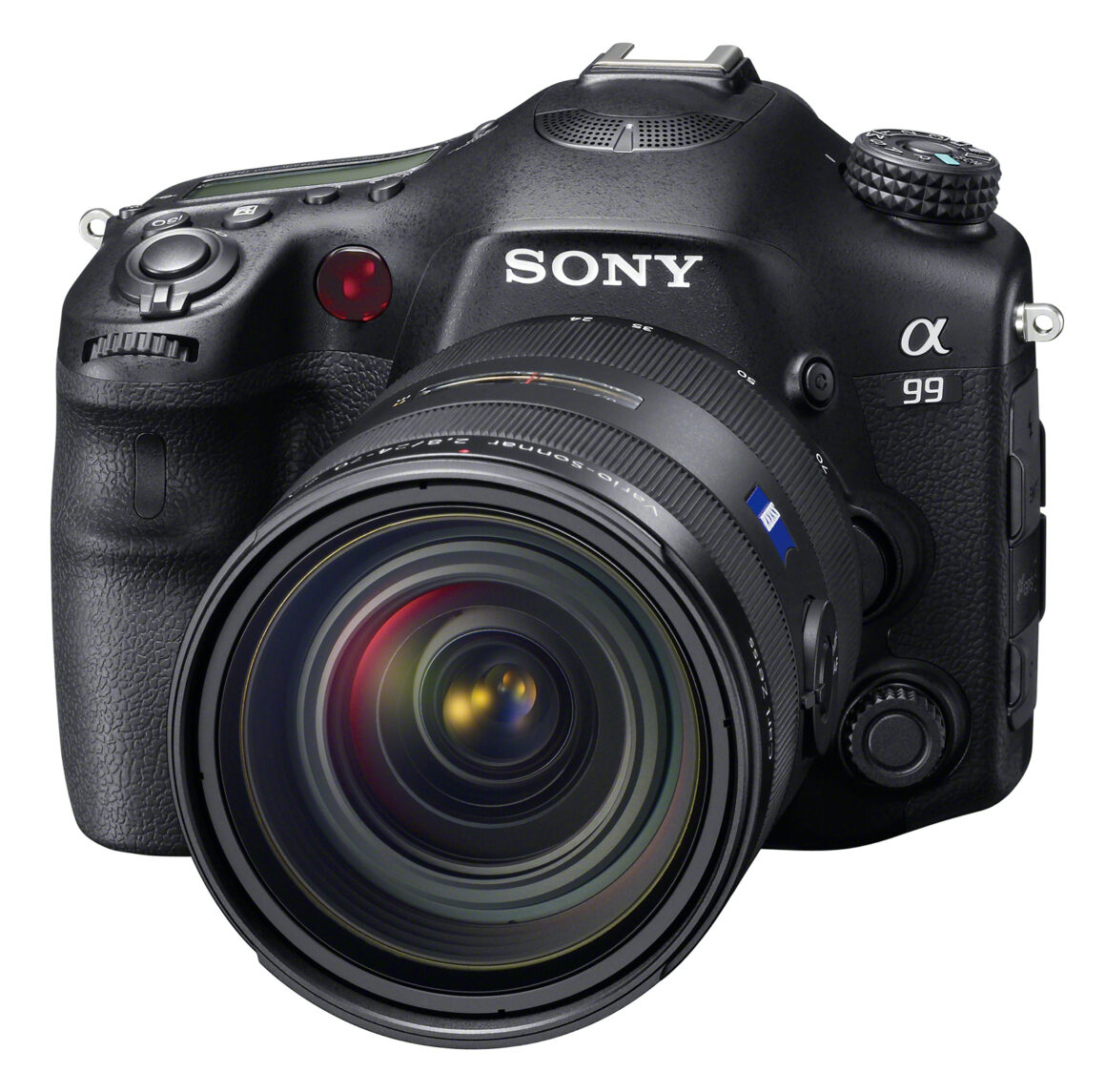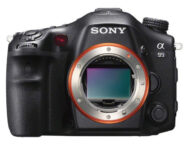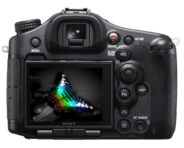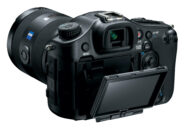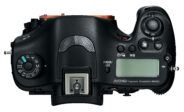Sony SLT-A99
35mm AF digital SLR camera
Specification
| Production details: | |
| Announced: | September 2012 |
| System: | ● Sony A (2008) |
| Format: | |
| Maximum format: | 35mm full frame |
| Imaging sensor: | 35.8 × 23.9mm CMOS sensor |
| Resolution: | 6000 × 4000 - 24 MP |
| Sensor-shift image stabilization: | Yes |
| Mount and Flange focal distance: | Minolta/Sony A [44.5mm] |
| Shutter: | |
| Type: | Focal-plane |
| Model: | Electronically controlled |
| Speeds: | 30 - 1/8000 + B |
| Exposure: | |
| Exposure metering: | Through-the-lens (TTL), open-aperture |
| Exposure modes: | Programmed Auto |
| Aperture-priority Auto | |
| Shutter-priority Auto | |
| Manual | |
| Physical characteristics: | |
| Weight: | 728g |
| Dimensions: | 147x111.2x78.4mm |
Manufacturer description
SAN DIEGO, Sept 12, 2012 – Sony’s long awaited α99 digital camera sets a new performance standard for professional-class DSLRs, combining all of the benefits of full-frame imaging with the responsiveness and speed of Translucent Mirror Technology.
The successor to Sony’s flagship α900 DSLR, the α99 camera features a brand new 24.3 MP full-frame image sensor, a unique dual phase-detect AF system and a host of other innovative technologies that work together to deliver the best image and full HD video quality in the history of Sony’s acclaimed line of α cameras.
“The new α99 camera is the ultimate combination of Sony’s expertise and rich history of image sensor production coupled with our truly innovative approach to camera design” said Mike Kahn, director of the alpha interchangeable lens camera division at Sony. “It redefines what can be accomplished with a full frame DSLR camera.”
New Levels of Imaging Performance and Response
The flagship α99 model combines its new 24.3 effective megapixel Exmor® CMOS sensor with a highly advanced BIONZ image processing engine, delivering unprecedented levels of performance in both still and video shooting.
The full frame sensor is enhanced by a newly-developed separate multi-segment optional low-pass filter, increasing its resolving power. Assisted by an all-new front-end LSI, the BIONZ engine can process massive amounts of image signal data from the sensor at very high speeds. Together with a powerful new area-specific noise reduction (NR) algorithm, it allows to the camera to achieve 14-bit RAW output, rich gradation and low noise.
The evolved BIONZ processor also gives the α99 model a maximum sensitivity range (in expanded sensitivity mode) as wide as ISO50 – 25600 – a range of nine stops. Its unprecedented processing power enables the camera to shoot a burst of images at up to six frames per second at full resolution or up to 10 fps in Tele-zoom high speed shooting mode.
The new α99 digital camera features a unique dual AF system, a world’s first for digital cameras. This camera’s main focusing system – a 19-point AF system with 11 cross sensors - is complemented by a 102-point focal plane phase-detection AF sensor overlaying the main image sensor. Harnessing the power of Translucent Mirror Technology, light is passed to both phase-detection AF sensors simultaneously and continually, measuring subject distance and position more completely than other cameras. This unique Dual AF System permits ultra-fast, accurate autofocusing that maintains tracking focus even if a subject temporarily leaves the frame.
The AF-D (depth) continuous autofocus mode* utilizes the Dual AF system for wider and more dense coverage of the frame, significantly improving AF performance with fast or erratically moving subjects against complex backgrounds. Additionally, during movie shooting, AF Duration control provides reliable depth focusing information and ensures that the camera maintains proper focus on its subject when objects or people cross the focal plane.
A new AF range control allows photographers to manually select foreground and background distance to which the AF system will not respond, especially useful for shooting fast moving sports or animals through a nearby wire mesh or in front of a complex background that commonly distracts camera AF systems.
Crafted for Videographers and Movie-makers
The new α99 camera’s video capabilities build on Sony’s expertise in developing professional motion picture cameras, combining the unmatched resolving power and sensitivity of the full-frame sensor with several advanced features optimized for professional video production.
The flagship α99 model is the first full-frame DSLR to offer Full HD 60p/24p progressive video recording to meet AVCHD™ Version 2.0 specifications and Full-time Continuous AF Movie mode, allowing smooth, non-stop tracking of moving subjects. Other enhancements include real-time Full HD video output via HDMI®, and uninterrupted ‘dual-card’ recording using both of the camera’s media slots.
For added convenience while shooting video, a new silent, programmable multi-control dial on the front of the camera body allows silent adjustment of common settings during shooting including exposure compensation, ISO sensitivity, shutter speed, aperture and much more.
The camera’s audio features are designed to meet the demanding needs of serious videographers. An audio level display and adjustable audio record levels are joined by a headphone jack for accurate in-the-field monitoring. Additionally, the multi-interface shoe provides balance audio input for the optional XLR-K1M adaptor kit, which adds a high-quality mono shotgun microphone and pro-standard XLR connections for dependable audio acquisition.
Uncompromised Handing for Advanced Photographers
The camera’s XGA OLED Tru-Finder™ viewfinder offers 100% frame coverage on the viewfinder screen with exceptional brightness, contrast, clarity and resolution, ensuring a detail-packed view of the desired scene and subject. The unique electronic viewfinder will also maintain a 100% field of view with DT lenses that are optimized for APS-C sensor cameras, converting the angle of view automatically for image recording and display.
Complementing the Tru-Finder EVF is a three-way tiltable 1229k-dot (VGA equivalent) XtraFine LCD™ display with WhiteMagic™ technology to boost overall screen brightness. It’s especially useful for framing and shooting with the LCD in outdoor, sunny conditions.
Despite its impressive pro-class credentials, the α99 camera is the world’s lightest 35 mm full-frame interchangeable-lens digital camera. Constructed of high-rigidity magnesium alloy panels, it weighs in at just 733g (without lens and battery). Translucent Mirror Technology, which eliminates the need for a full-frame moving mirror mechanism and heavy glass pentaprism, also contributes to the extremely light design.
Additionally, the camera is weather-sealed and all buttons and controls have been ruggedized. A redesigned shutter block, tested to approximately 200,000 releases, further ensures the camera’s stamina and reliability.
The camera’s enhanced ergonomics include a re-designed grip and differentiated designs of several switches and buttons that allow for intuitive fingertip operation. A new exposure mode dial lock prevents accidental rotation, and a newly-developed Quick Navi Pro interface gives quick, intuitive one-handed access to common shooting parameters and controls.
The new model can also be operated via remote PC connection. Supported functions include switching between still and video shooting plus automatic transfer of still images from camera to PC for an improved studio workflow.
Designed for Professionals: New α Lens and Accessories
The full-frame imaging capabilities of the α99 camera make it an ideal partner for the new 300mm F2.8 G SSM II (SAL300F28G2) lens. Designed for demanding sports and wildlife applications, this bright super-telephoto offers a significantly improved optical design and handling compared with its predecessor. The Sony-developed Nano AR Coating assures flawless still images and HD video with reduced flare and ghosting, offering enhanced contrast. Further, a new LSI drive circuit offers faster, more accurate autofocus with enhanced subject tracking. The new lens is also dust- and moisture-resistant, making it an ideal candidate for the toughest outdoor shooting assignments.
Additionally, a new wide-aperture Carl Zeiss® A-mount prime lens is now under development. Optimized for superb results with the camera’s new 35mm full frame image sensor, the Planar T* 50mm F1.4 ZA SSM will be available next spring.
Offered exclusively for the α99 camera, the brand-new VG-C99AM vertical grip can house and manage three batteries in total (including the camera’s own on-board battery). Resistant to dust and moisture, the grip is ideal for lengthy shooting sessions in the studio or outdoors.
The brand new, range-leading HVL-F60M is a powerful flash (GN60, in meters at ISO 100) with built-in LED light that’s ideal for creative applications with still image or movie shooting. Smart functions include wireless multi-flash ratio control and Sony’s unique Quick Shift Bounce adjustment, while operation can be controlled quickly via the flash’s intuitive Quick Navi system. Also resistant to dust and moisture, the HVL-F60M flash comes supplied with a bounce adaptor for flash and a color conversion filter for use with LED lighting.
Compatible with 49mm and 55mm diameter lenses, the new HVL-RL1 Ring Light offers highly effective LED illumination of small subjects and is ideal for macro shooting**. Its high output level (approx. 700 lx/0.3m) is approximately four times brighter than the previous model, and operation can be switched between full-ring illumination and half-ring illumination.
The new XLR-K1M XLR Adaptor Kit is designed to meet the most demanding audio needs. It provides two pro-standard XLR terminals for connecting the α99 camera with professional microphones and mixing consoles and offers MIC/LINE input selection and separate adjustment of two channel levels to maximize operating flexibility. The adaptor kit comes supplied with Sony professional ECM-XM1 monaural shotgun microphone, but may also be used with a wide range of professional microphones. An optional bracket is required when using the XLR-K1M kit with the α99 model.
The RMT-DSLR2 Remote Commander allows wireless shutter release for still images and start/stop control of video shooting. It’s compatible with the new α99 models as well as other α A-mount and E-mount cameras that include a remote control receiver.
Styled to reduce carrying fatigue, the new LCS-BP3 Backpack can hold the α99 camera body, an attached telephoto zoom lens plus the VG-A99AM vertical grip as well as three to four spare lenses, accessories and a laptop up to 15.5”.
The ADP-MAA is a new shoe adaptor that allows Multi Interface Shoe cameras to be used with Auto-lock Accessory Shoe accessories. This adaptor will be supplied with the new HVL-60M flash and HVL-RL1 ring light mentioned above. Conversely, the ADP-AMA shoe adaptor allows Auto-lock Accessory Shoe cameras to be used with Multi Interface Shoe accessories.
Lastly, the PCK-LM14 Screen Protector Semi Hard Sheet safeguards the camera’s LCD screen against dust, scratches and fingerprints, and is supplied with a separate protector sheet for the top display panel.
Sony’s new SDXC memory UHS-1 memory card, SF-64UX (64 GB) is ideal for burst shooting with the α99. It’s ultra-high speed interface (UHS-1) compatibility offers high transfer speeds up to 94 MB/s (read) and rapid data rates when transferring large RAW files of video files to PC. The new cards are water-resistant and designed to perform under a wide range of operating temperatures. For additional data integrity, Sony’s File Rescue Software can help recover photos and videos that may have been accidentally deleted.
